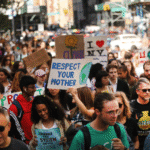By Tom Bearpark, Ashwin Rode and Archana Patankar
Rainfall and flooding frequently disrupt the lives of urban residents worldwide, posing significant public health risks. Rapid urbanisation is exposing larger and more vulnerable populations to flooding, while climate change intensifies rainfall patterns and rising sea levels impair drainage systems. Despite the growing recognition and urgency of these hazards, the health impacts of rainfall remain poorly understood, and those of sea level rise are entirely unquantified. Here, we estimate the mortality consequences of rainfall in one of the world’s largest cities – Mumbai, India. We integrate high-resolution data on rainfall, tides, and mortality, to analyse how unmanaged rainfall and its interaction with tidal dynamics contribute to urban health risks. We find that rainfall causes more than 8% of Mumbai’s deaths during the monsoon season, and that more than 80% of this burden is borne by slum-residents. Children face the biggest increase in mortality risk from rainfall, and women face a greater risk than men. Additionally, we demonstrate that mortality risk from rainfall increases sharply during high tides and use this relationship to evaluate how rising sea levels could amplify rainfall- induced mortality in the absence of adaptation. Our findings reveal that the mortality impacts of rainfall are an order of magnitude larger than is documented by official statistics, highlighting the urgent need for investment in improved drainage, sanitation, and waste management infrastructure.
























